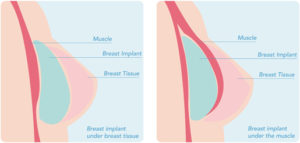Breast Augmentation Approaches
There are essentially three approaches used in breast augmentation to put in an implant.
an implant.
- Periareolar Incision: Periareolar incision is made along the bottom half of the areola, the pigmented area that surrounds the nipple. This scar is nearly invisible as it is very well camouflaged, as it is in the conference of the dark and the light skin. However, since you go through the gland and
 make a pocket behind the gland or behind the muscle. In this process there may be chances of lactiferous ducts getting injured. All these lactiferous ducts and the breast glands may have some microorganisms present as well. Whenever there are microorganisms there may be chances of infection or biofilm formation which could lead to capsular contracture.
make a pocket behind the gland or behind the muscle. In this process there may be chances of lactiferous ducts getting injured. All these lactiferous ducts and the breast glands may have some microorganisms present as well. Whenever there are microorganisms there may be chances of infection or biofilm formation which could lead to capsular contracture.
Periareolar incision can also include the risk of loss of sensitivity of the nipple, especially in women with smaller areolas and could damage the milk ducts thus hindering in breast-feeding.
- Axillary Incision: This involves an incision made within the armpit through which the implant is places. It has been seen that through the axillary incision, it is very difficult to go up to the middle most portion of the breast. With this approach, the patients get a much wider shape of the breast and thus doesn’t get a good cleavage as breasts may fall laterally apart. Another drawback of this approach is that the incision is always seen when you are wearing sleeveless dress.
- Inframammary incision: This incision is most preferred incision by the top plastic surgeons globally. With this incision the surgeon can go directly behind the breast gland without touching the gland at all. In this approach, a pocket can be made sub-glandular or dual plane(which is behind the muscle). Since with this approach, the gland is not touched, there is no chance of lactiferous ducts getting injured and chances are infection are also minimal. The scar with this incision is also not visible even if you are standing naked as the incision is underneath the breast. This scar fades away really well within few months with ointments suggested by the surgeon.
The plane for Breast Implant Placement Prepare for the surgery
The breast implant can be placed in two planes, subfascial place and dual plane. Between the two, each has their advantages and disadvantages.
plane. Between the two, each has their advantages and disadvantages.
- In Subfascial Plane, the implant is placed behind the gland. Subfascial is done in females who want their upper pole fullness should be too much or they want more cleavage. This gives them a rounder appearance in the upper pole.
- In Dual Plane, the implant is covered by the muscle in the upper half and the breast gland in the lower half, giving it a more natural look in an anatomical shape. Dual plane implant is recommended for females who have very less skin thickness and breast thickness so that the implant itself doesn’t show on your skin.
When we asked one of the top plastic surgeon, Dr Rajat Gupta, he said that he always examines his patients for the upper pole thickness. If the skin thickness is more than 2 cms, one can still opt for Subfascial plane, else dual plane approach. He also told us that of late, more and more patients now want the natural look and hence are opting for dual plane implant placement!

